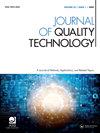一种用于检测高维异方差数据稀疏均值变化的基于变化点的控制图
IF 2.2
2区 工程技术
Q2 ENGINEERING, INDUSTRIAL
引用次数: 1
摘要
摘要由于“维度诅咒”的存在,高维过程对传统的多元统计过程监控(SPM)技术提出了挑战。此外,异方差等变量的潜在分布未知和变量间复杂的依赖关系增加了参数估计的不确定性,降低了控制图的有效性。此外,对足够参考样本的要求限制了传统图表在高维、低样本场景(小n,大p)中的应用,当检测和诊断由少量变量(即稀疏变化)引起的异常行为时,会出现更多的困难。在本文中,我们提出了两个基于变化点的控制图来检测高维异方差过程的平均向量的稀疏移位。我们提出的方法可以在观测数远小于维数的情况下开始监测。仿真结果表明,该方法对非正态性和异方差具有较强的鲁棒性。用两个实际数据实例说明了所提出的控制图在高维应用中的有效性。R码在网上提供。关键词:变化点方差高维控制图稀疏变化统计过程监控(SPM)披露声明作者未报告潜在利益冲突。作者简介:王泽忠,博士,毕业于香港城市大学系统工程系。她是香港工业人工智能及机器人中心(FLAIR)的博士后研究员。她的研究兴趣包括统计过程监控、数据科学和人工智能应用。她的电子邮件地址是zzwang@hkflair.org.Inez Maria Zwetsloot inez M. Zwetsloot是荷兰阿姆斯特丹大学商业分析系副教授。她曾任香港城市大学系统工程系助理教授。她是青年统计学家奖(ENBIS, 2021)和费根鲍姆奖章(ASQ, 2021)的获得者。她的研究重点是使用统计和分析来解决使用数据的业务挑战。这包括统计过程监控、网络分析、质量工程和数据科学方面的工作。她的电子邮件地址是i.m.zwetsloot@uva.nl。本文章由计算机程序翻译,如有差异,请以英文原文为准。
A change-point–based control chart for detecting sparse mean changes in high-dimensional heteroscedastic data
AbstractBecause of the “curse of dimensionality,” high-dimensional processes present challenges to traditional multivariate statistical process monitoring (SPM) techniques. In addition, the unknown underlying distribution of and complicated dependency among variables such as heteroscedasticity increase the uncertainty of estimated parameters and decrease the effectiveness of control charts. In addition, the requirement of sufficient reference samples limits the application of traditional charts in high-dimension, low-sample-size scenarios (small n, large p). More difficulties appear when detecting and diagnosing abnormal behaviors caused by a small set of variables (i.e., sparse changes). In this article, we propose two change-point–based control charts to detect sparse shifts in the mean vector of high-dimensional heteroscedastic processes. Our proposed methods can start monitoring when the number of observations is a lot smaller than the dimensionality. The simulation results show that the proposed methods are robust to nonnormality and heteroscedasticity. Two real data examples are used to illustrate the effectiveness of the proposed control charts in high-dimensional applications. The R codes are provided online.Keywords: change-pointheteroscedasticityhigh-dimensional control chartsparse changesstatistical process monitoring (SPM) Disclosure statementNo potential conflict of interest was reported by the author(s).Additional informationNotes on contributorsZezhong WangZezhong Wang received her doctoral degree from the Department of Systems Engineering, City University of Hong Kong. She is a postdoc researcher at the Hong Kong Industrial Artificial Intelligence and Robotics Centre (FLAIR). Her research interests include statistical process monitoring, data science, and artificial intelligence applications. Her email address is zzwang@hkflair.org.Inez Maria ZwetslootInez M. Zwetsloot is an associate professor in the Department of Business Analytics at the University of Amsterdam, The Netherlands. Previously she was assistant professor at the Department of Systems Engineering, City University of Hong Kong. She is the recipient of the Young Statistician Award (ENBIS, 2021) and the Feigenbaum Medal (ASQ, 2021). Her research focuses on using statistics and analytics for solving business challenges using data. This includes work on statistical process monitoring, network analytics, quality engineering, and data science. Her email address is i.m.zwetsloot@uva.nl.
求助全文
通过发布文献求助,成功后即可免费获取论文全文。
去求助
来源期刊

Journal of Quality Technology
管理科学-工程:工业
CiteScore
5.20
自引率
4.00%
发文量
23
审稿时长
>12 weeks
期刊介绍:
The objective of Journal of Quality Technology is to contribute to the technical advancement of the field of quality technology by publishing papers that emphasize the practical applicability of new techniques, instructive examples of the operation of existing techniques and results of historical researches. Expository, review, and tutorial papers are also acceptable if they are written in a style suitable for practicing engineers.
Sample our Mathematics & Statistics journals, sign in here to start your FREE access for 14 days
 求助内容:
求助内容: 应助结果提醒方式:
应助结果提醒方式:


